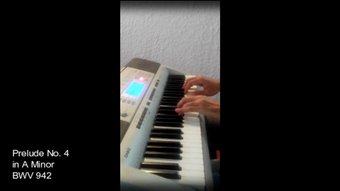Mi Versión del Preludio Op 28, N° 4 de F. Chopin
10
About :
Después de un tiempo ausente, vuelvo ahora explorando la profundidad musical del Preludio Op. 28, No. 4 de Chopin. Si hay una obra que captura la esencia melancólica de Frédéric Chopin, indudablemente es este pequeño preludio, un tesoro musical que forma parte de su famoso conjunto de preludios, y que nos transporta a un mundo de emotividad y complejidad interpretativa, revelando la maestría del compositor polaco. Me atrevo a interpretar esta obra sabiéndome condenado a solo conseguir una aproximación torpe y muy lejana, aun así lo intentaré.
Publicado por primera vez en 1839, este preludio es parte integral de los 24 preludios que Chopin escribió durante su estancia en Valldemossa, Mallorca. Cada preludio en esta colección aborda una tonalidad diferente, siguiendo el círculo de quintas. El Op. 28, No. 4 está en mi menor, y su atmósfera melódica y expresiva ha dejado una marca perdurable en la música de todos los tiempos. Por ejemplo, Antonio Carlos Jobim se inspiraría en esta obra para componer "Insensatez", una canción que transcurre con una cálida y relajante progresión de acordes al ritmo de la Bossa-Nova.
Desde los primeros compases, el Preludio Op. 28, No. 4 cautiva con su melancolía y misterio. La melodía refleja el estado anímico de Chopin durante aquel periodo. La pieza es un diálogo apasionado entre la melancolía y la esperanza, destacando la capacidad única de Chopin para transmitir emociones a través de las teclas.
Algunos creen que que este preludio expresa la agonía que Chopin sufría por causa de sus problemas respiratorios.
El Preludio Op. 28, No. 4 continúa siendo interpretado por pianistas de todo el mundo, su poderosa simplicidad y complejidad emocional no han perdido su fascinación. Desde su creación hasta nuestros días, esta obra maestra musical sigue siendo un recordatorio perdurable del genio de Chopin y su capacidad para comunicar lo inefable a través de la música.
Espero que disfrutes explorando la riqueza musical de este preludio tanto como yo. Antes de despedirme, quiero aprovechar de darte las gracias por haberte quedado hasta el final, y también quiero preguntarte si piensas que esta obra es una joya de todos los tiempos.
Pincha este enlace para ver mi publicación anterior
¡Paz y Bien!
English Version
After a time away, I now return exploring the musical depth of Chopin's Prelude Op. 28, No. 4. If there is a work that captures the melancholic essence of Frédéric Chopin, it is undoubtedly this small prelude, a musical treasure that is part of his famous set of preludes, and that transports us to a world of emotion and interpretive complexity, revealing the composer's mastery. Polish. I dare to interpret this work knowing that I am condemned to only achieving a clumsy and very distant approximation, even so I will try.
First published in 1839, this prelude is an integral part of the 24 preludes that Chopin wrote during his stay in Valldemossa, Mallorca. Each prelude in this collection addresses a different key, following the circle of fifths. Op. 28, No. 4 is in E minor, and its melodic and expressive atmosphere has left a lasting mark on music of all time. For example, Antonio Carlos Jobim would be inspired by this work to compose "Insensatez", a song that runs with a warm and relaxing chord progression to the rhythm of the Bossa-Nova.
From the first bars, the Prelude Op. 28, No. 4 captivates with its melancholy and mystery. The melody reflects Chopin's emotional state during that period. The piece is a passionate dialogue between melancholy and hope, highlighting Chopin's unique ability to convey emotions through the keys.
Some believe that this prelude expresses the agony that Chopin suffered due to his breathing problems.
The Prelude Op. 28, No. 4 continues to be performed by pianists around the world, its powerful simplicity and emotional complexity having lost none of its fascination. From its creation to the present day, this musical masterpiece remains an enduring reminder of Chopin's genius and his ability to communicate the ineffable through music.
I hope you enjoy exploring the musical richness of this prelude as much as I do. Before saying goodbye, I want to take the opportunity to thank you for having stayed until the end, and I also want to ask you if you think that this work is a gem of all time.
Click this link to see my previous post
Peace and good!
Tags :
Their limit for today is $0!




























Comments:
Reply:
To comment on this video please connect a HIVE account to your profile: Connect HIVE Account